The Most Complete Content Marketing Process Guide You Need to Get Organized
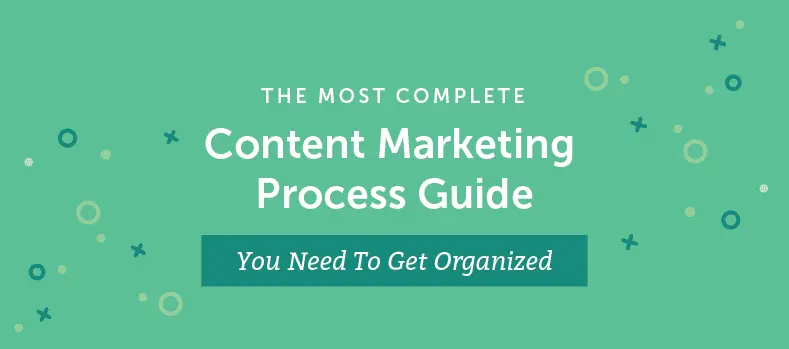 Content marketing is deceptively complex. On its surface, it may appear simple: create content, push it out into the world, and watch the leads pour in. However, in actual practice, there are a lot of moving parts that need to be synchronized for success. From strategy to execution to measurement, there is more involved than what immediately meets the eye.
This disconnect between expectations and reality can quickly derail an organization’s attempts to get started with content. When CMOs and client stakeholders lack a clear understanding of the strategy and workflow development required to achieve success, the results can easily fail to produce a measurable return on investment and keep those stakeholders happy.
Developing an understanding of how the complete content marketing process functions doesn’t have to be difficult though. Having an outline from start to finish illustrating how things work can help convince clients and stakeholders that success isn’t as simple as starting a blog, shooting some videos, or publishing an optimal number of social media posts.
In this blog post, you’ll get:
Content marketing is deceptively complex. On its surface, it may appear simple: create content, push it out into the world, and watch the leads pour in. However, in actual practice, there are a lot of moving parts that need to be synchronized for success. From strategy to execution to measurement, there is more involved than what immediately meets the eye.
This disconnect between expectations and reality can quickly derail an organization’s attempts to get started with content. When CMOs and client stakeholders lack a clear understanding of the strategy and workflow development required to achieve success, the results can easily fail to produce a measurable return on investment and keep those stakeholders happy.
Developing an understanding of how the complete content marketing process functions doesn’t have to be difficult though. Having an outline from start to finish illustrating how things work can help convince clients and stakeholders that success isn’t as simple as starting a blog, shooting some videos, or publishing an optimal number of social media posts.
In this blog post, you’ll get:
- A clear explanation of how content marketing works through the entire process.
- Tons of links to related blog posts that dive deep into each area.
- Templates to help your team get started with documenting strategy and workflows.
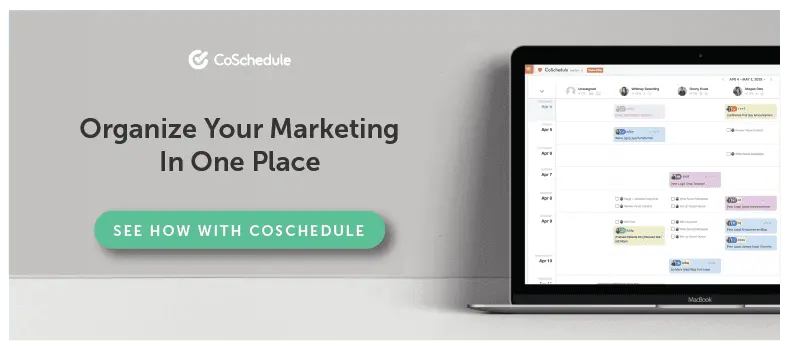
Manage Your Content Marketing Production Process With 30 Templates, Infographics, and More
Executing effectively throughout this process isn't easy. To help you on your journey, we've pulled together 30 free resources you can start using right now. This bundle includes templates, guides, worksheets, and more. There's something for every part of your content marketing workflow, and we'd encourage you to download it now before moving on.What Does a Content Creation Process Look Like?
There are a lot of different models and maps charting out the content marketing process. For our purposes, we’ll break it down into the following five buckets:- Content Planning and Strategy: This includes everything involved in developing an overarching plan and strategy for your content.
- Content Creation: This includes everything involved in creation processes and workflows.
- Content Publishing: This includes everything involved in establishing publishing schedules and cadences.
- Content Distribution and Promotion: This includes everything involved in promoting a piece of content.
- Content Measurement: This includes everything involved in analyzing performance and extracting insights to refine your content strategy in the future.

Your Content Marketing Process Library
When writing this post, we realized that tackling the entire content planning, creation, promotion, and measurement process in one post is a tall order. If you're looking for something specific, click through to one of the following posts:Content Planning and Strategy
- How to Plan and Execute an Effective Content Strategy That Will Quadruple Your Results (Template)
- How to Build a Content Marketing Strategy You'll Actually Use (Template)
- The Ultimate Marketing Campaign Planning Checklist That Will Get You Proactive
- Spark Your User Persona to Life With These 9 Important Tools
- How to Find Your Target Audience and Create the Best Content That Connects
Content Creation
- 40 Content Writing Tips to Make You a Better Marketer Now
- The Best Social Media Copywriting Guide to Be a Social Word Ninja
- The Most Massive SEO Copywriting Guide That Will Make Your Traffic Soar
- The Ultimate Blog Writing Process to Create Killer Posts
- The Email Copywriting Process You Need to Get More Conversions
- How to Work With Designers With Authentic Advice From CoSchedule's Designer
- How to Make an Infographic Like a Pro in 7 Easy Steps
Content Publishing
Content Promotion and Distribution
Content Measurement and Analytics
Phase 1: Content Strategy + Planning
Everything starts with smart planning.Understanding Your Audience
Who are you creating content for? What are their greatest wants, needs, and pain points? These are some of the first questions you’ll need to answer when developing your process. Figuring out who your audience is doesn’t have to be as hard as it sounds. Do some digging, though, and you might find that your real audience differs from the one you thought you had. To begin, answer four questions:- What problems does my company, product, or service solve? If you’re in business at all, this should (hopefully) be easy enough to answer. How do you make customers lives better or easier?
- Who are our current customers? Who’s buying your product right now? Make a mental note if that’s different from who you want to be buying your product.
- Who is my competition? You probably know who your top competitors are. However, do some quick keyword searches on Google, Facebook, and Twitter to see if you can turn up any more you weren’t aware of.
- What sets us apart from our competition? Why would people choose you instead?
- What topics your content needs to cover and which questions it should answer.
- Who is going to read, watch, or listen to that content.
- What your competition is doing (and start thinking about how you can improve on their efforts).
- What you need to do to set your content apart (so people consume your stuff instead of your competitors’).
“[OUR COMPANY] creates content to help [INSERT DEMOGRAPHIC] do [INSERT ACTION] better.”Then, establish what we call your “content core.” This means identifying two things:
- What you do (and the topics that matter most to your company).
- What your audience cares about (which probably includes topics you should cover, even if they only loosely correlate with what your company does).
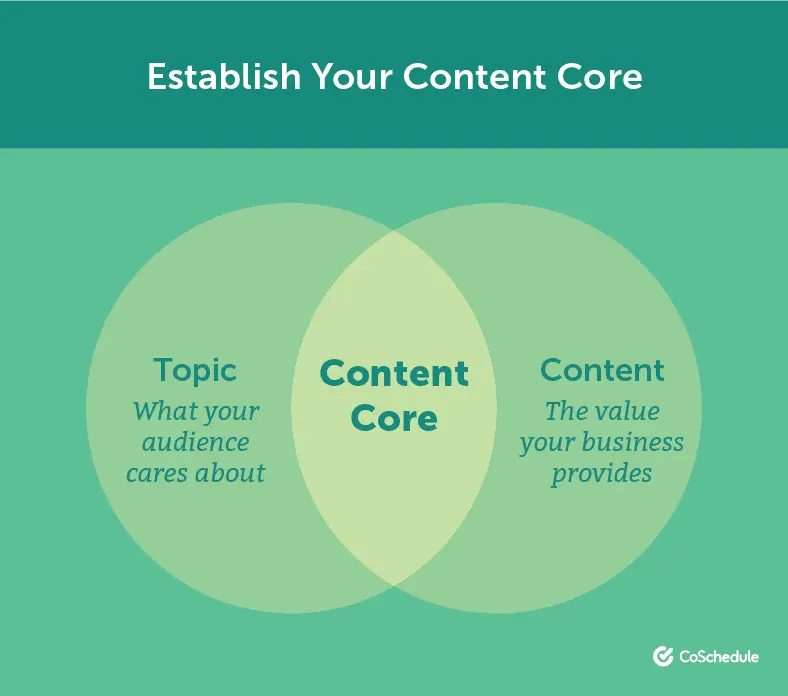 Here are a few simple ways to get started doing this:
Here are a few simple ways to get started doing this:
- Dig through your social media followers feeds. What are they sharing on Twitter?
- Run an audience survey. Use something like Polldaddy or Survey Monkey and ask customers or blog readers what they’re interested in (and what topics they want your content to cover.
- Look at your competition’s content. You shouldn’t necessarily copy what they’re doing. However, taking note of what they’re creating can give you some clues at what their audience finds relevant (provided they’re doing a good job).
Developing Personas
If you’re not deeply familiar with your audience, then building personas can be vital for understanding who you’re targeting. This is especially true when working in industries where you don’t consider yourself a deep subject matter expert (SME). This process can get fairly involved, but it doesn’t necessarily need to be overly complicated. What makes personas such an importance piece of the content marketing process? This graphic summarizes that with a few powerful stats: A persona is a simple character description of your average customer or audience member. To build out a simple user persona, you should include the following information:
A persona is a simple character description of your average customer or audience member. To build out a simple user persona, you should include the following information:
- Age
- Location
- Occupation
- Income Level
- Level of Education
- Hobbies
- Challenges and Goals
- Personality Summary
- Values and Fears
- Favorite Blogs, News Sources, and Companies
Establish Your Goals
Have a plan for how you’ll set goals for each project and campaign you execute. While goals may vary based on each project, having one set methodology for determining goals makes setting them easier. One common goal-setting framework we recommend is the SMART system. SMART goals are:- Specific. Goals should be laser-focused on moving set metrics KPIs.
- Measurable. They should be quantifiable and able to be backed up with real numbers.
- Actionable. Can you take specific steps to achieve this goal?
- Realistic. Increasing revenue by 1 million percent is probably not realistic. Use your best judgment.
- Timely. Achieving goals should help move your organization forward in ways that are relevant right now.
 Then, to write a simple goal statement (whether for your overall business and marketing goals, or for a specific channel, campaign, or project), follow this template:
Then, to write a simple goal statement (whether for your overall business and marketing goals, or for a specific channel, campaign, or project), follow this template:
![By [day, month, year] my [PR or marketing type] will reach [number of goal] every [time frame] that will [impact of growth]](https://media.coschedule.com/uploads/2019/05/smart-goals-template.png?w=3840&q=75) You can adjust the specific verbiage as necessary. What’s necessary is that you plainly state the following:
You can adjust the specific verbiage as necessary. What’s necessary is that you plainly state the following:
- What you hope to achieve.
- When you hope to achieve it by.
- How To Set Marketing Goals You Can Actually Achieve from Neil Patel
- How to Set Marketing Goals Based on Business Goals from ImpactBND
- How to Define SMART Marketing Objectives from Smart Metrics
Here's how to set SMART marketing goals (and manage the rest of your content marketing process, too):
Click To TweetDevelop Your Content Strategy
This is an enormous topic in itself. In fact, several books have been written on the subject (and you should read them). Arguably, a lot of what we cover in this post also covers content strategy and content marketing strategy (there’s a subtle difference). For our purposes here, we’ll break down content strategy into its absolute most basic elements. Then, we’ll point you in the right direction to learn more. To begin, let’s answer three questions:- What will you create? This means the kinds of content and channels you’ll use.
- Why will you create it? This ties back into your goals and the specific needs your content should address.
- How will you measure success? This entails establishing the specific metrics you’ll track against.
Performing Content Audits
How can you make sure you create more content that works, cut out what doesn’t, and avoid duplicating effort? The answer is by performing regular content audits. Pam Neely put together this excellent guide (and content audit template) that dives deep into this process. At a high level, here are some things to look for when evaluating past content: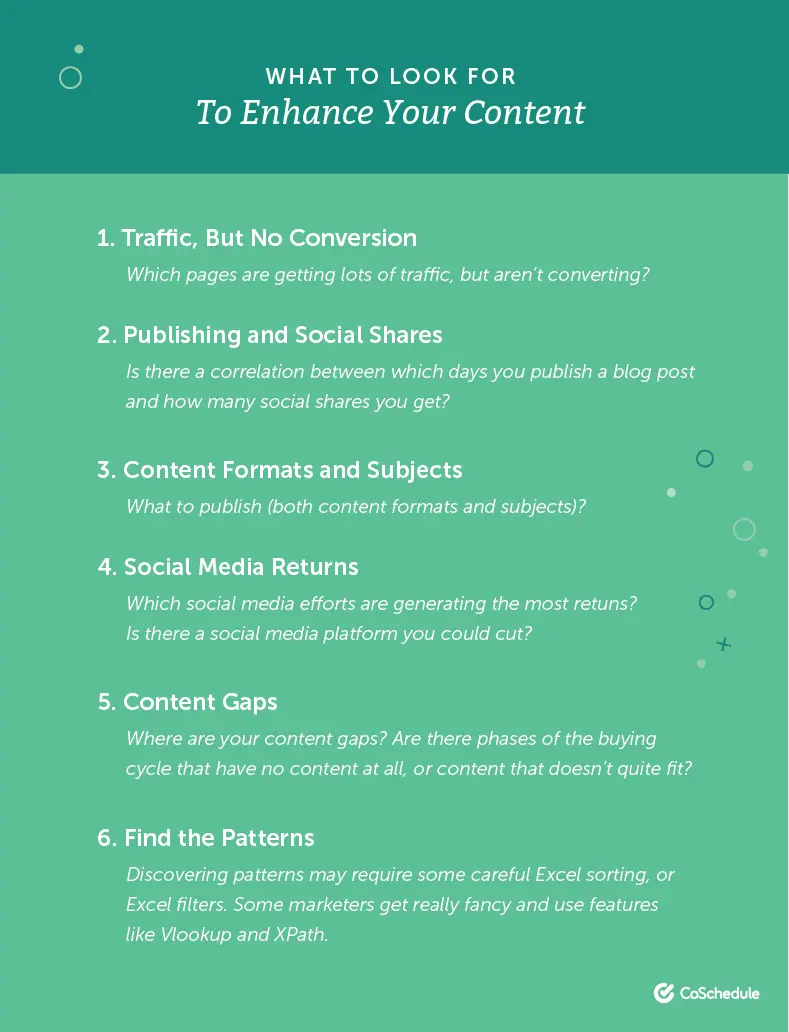
Generating Ideas
How will you generate ideas for projects and campaigns? Quality creative concepts and campaign ideas don’t happen by accident (most of the time). Everything you create should also be connected to your overall goals. So, how do you come up with great ideas that actually move the needle? Start by figuring out who will be involved in your ideation process:- Clients or internal stakeholders. Campaigns often start as solutions to problems your clients or your company is facing.
- Your CEO, CMO, and senior strategists. These folks are close to your organization’s overall goal-setting.
- Your do-ers down in the trenches (writers, designers, etc.). You hire creative people to be creative, right?
- Solo strategy sessions where individual team members generate project, content, and campaign ideas on their own.
- Group brainstorming sessions where multiple team members collaborate on ideation.
- Get your team in a room and have them write down every idea they can think of in ten minutes.
- Have one person read every idea out loud. Then, have each team member rate those ideas on a three-point scale. Three’s are definite ideas you should execute, two’s are ideas that need some work, and one’s are, well, crap. If you do this right, the process will yield ideas all across the board (and that’s okay).
- Take every idea that’s a unanimous three and narrow down the ones you’ll settle on.
Phase 2: Content Creation
You’ve got your planning processes in place. Now, let’s move onto the execution steps. How will content marketing projects and ideas be brought to life?Establish Team Roles
Team roles may be different than actual job titles. What we’re looking to know here is what people will actually be doing when it comes to planning, publishing, and promoting content.Understanding Keyword Research
Keyword research is vital for creating content your audience wants. At its simplest level, it should achieve three goals:- Helping you understand what people want to read. This typically means stuff that answers questions and solves problems for them.
- Helping you understand the intent behind keywords. Carefully analyze search results for keyword terms to ensure people are really looking for what you think they are.
- Helping you understand what you can rank on. Most keyword tools show keyword difficulty and competition.
-
- Develop a strategy to build your email list. Gated content upgrades in blog posts and building landing pages with opt-in forms are two ways to do this.
- Plot out an email sending schedule. This guide will help you select the best days and times to send e-newsletters.
- Plan an email content creation process. This will entail:
- Writing your email copy.
- Designing email templates (if you’re coding your own emails) or placing content into a template within your email marketing service provider.
- Analyzing the performance per email.
- Repeat.
Recommended Reading: Your Ultimate Content Marketer’s Guide to Keyword Research
Building Checklists, Templates, and Other Reusable Assets
Having pre-built checklists and templates for every type of content you produce can help make creating content that’s consistent easier. They help reinforce productive workflows and ensure that every project gets executed the right way, every time. There are a couple of ways to approach this:- Use our pre-built checklist here, or any of the templates bundled within this post you’re reading right now.
- Build your own checklists and templates.
- List everything that’s needed to complete a specific type of content. Be thorough.
- Assign each task to the appropriate team member. This could be either a specific person or just the role required.
- Estimate how long each step takes to complete. If you’re not sure, track your time over the course of creating a few pieces to set benchmarks.
- Document all of those steps and make your checklist easily accessible to your team. Consider using something like a shared Google Drive or Dropbox folder to store all your checklists.
Writing + Design
Getting writers and designers working well together is key for content marketing success. By establishing clear processes for each, you can eliminate a lot of confusion and head-butting around expectations. A basic workflow might look like this:- Writer drafts content in a template or document.
- Then, writer and designer discuss images to include.
- Designer takes direction and adds other images where necessary.
Recommended Reading:Phase 3: Content Publishing
Once workflows and processes for content creation have been put in place, determine how often content will be published, and establish processes for managing your cadence.Establish How Often You'll Publish Each Type of Content You Create
There are no objectively correct answers to how much content is enough or how much is too much. But, the following posts can help offer some starting points:- How Often to Post on Social Media [Proven Research From 14 Studies]
- The Best Email Sending Frequency [Backed By 20 Studies]
- The Perfect Blog Post Length and Publishing Frequency is B?!!$#÷x [Whiteboard Friday from Moz]
Planning Your Content Marketing Calendar
We strongly recommend planning every piece of content you publish on one unified marketing calendar. Whether you use a spreadsheet or an app (we’re partial to CoSchedule ourselves), your calendar should achieve the following objectives:- It should give your entire team one place to see every project in progress.
- A place to map out all your deadlines.
- A means of keeping everything organized so nothing gets lost or forgotten.
Recommended Reading:Phase 4: Content Promotion + Distribution
Content promotion often gets overlooked. If you’re not thoroughly planning your promotion processes, though, it’s time to start.Social Media
Assuming you’ll be creating social media posts to promote other content (in addition to standalone social content), you’ll need to plan a few things:- Your channel selection. Which channels are you on, and which are most important for you?
- A promotional posting schedule for each type of content you’ll be promoting. Planned posting templates save time wondering how many posts to prepare.
- An understanding of social media analytics. Monitoring what works and what doesn’t will help you make the most of your time in the long run.
Recommended Reading:Email Marketing
Email marketing delivers 4,000% ROI. According to Campaign Monitor, it also 40 times more effective for customer acquisition than social media. So, have a plan to make the most of it.
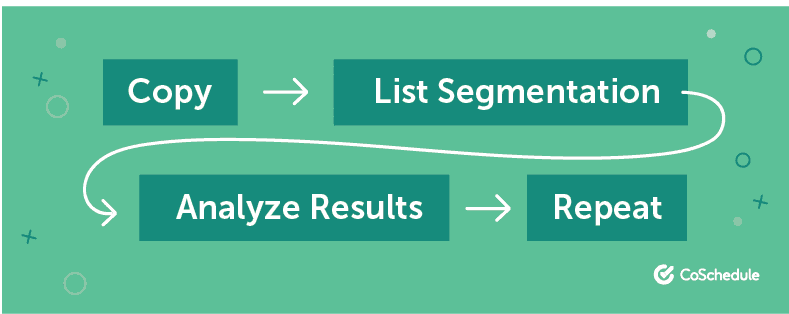 Recommended Reading:
Recommended Reading:Search Engine Optimization
Search engine optimization is necessary for ensuring your content garners continued traffic (even after your social media and email promotion have run their course). On a basic level, be sure to check off the following for every piece of content you publish (assuming you’re creating blog posts or website pages):- Title tags. These are the blue links at the top of search results. They should include your target keyword and accurately describe your content. They should be 70 characters or less.
- Meta descriptions. This is the descriptive text beneath the blue links in search results. They don’t directly impact rankings but do influence click-through rates. They should be 150 characters or less (but not too short).
- Portent’s SERP Preview Tool: It’s a little bit outdated (Google no longer uses pixel width to cap title tag length), but it can still help you see what search snippets will look like:
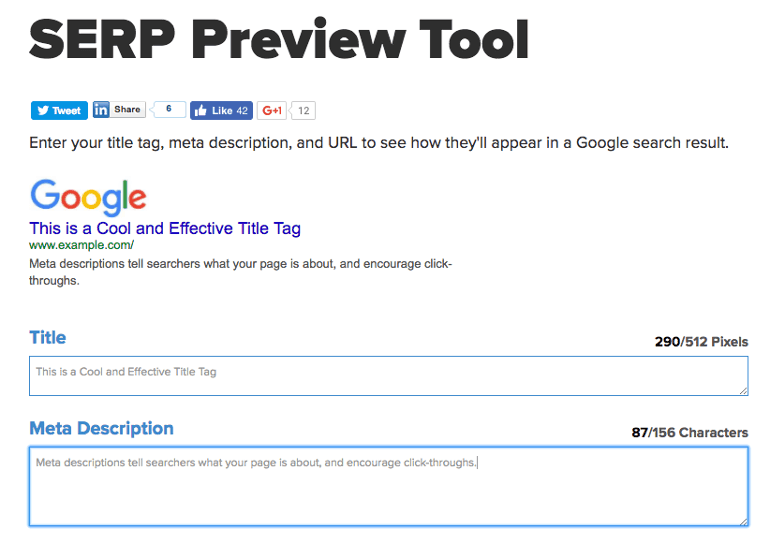
- Spotibo SERP Preview Tool: Another free option that works well.
- Yoast: If you’re using WordPress and Yoast, you’ll see a preview of your title tag and meta description before you publish.
- Keyword targeting. Does your content target a specific keyword phrase?
- Latent semantic indexing. In plain English, does your content include terms relevant to your primary topic?
- Keyword placement within your content. Is your primary keyword in your URL, H1, and body content? Are secondary keywords naturally integrated into your copy?
- How to Boost Traffic With 34 Important SEO Tips You Need to Know
- How to Maximize Your On-Page SEO in 2017 With One Awesome Checklist
- SEO Content Strategy: How to Skyrocket Your Traffic By 594%
PR / Outreach
What’s one of the best ways to promote your content? Tell people directly who might be interested in it! Of course, you’ll want to be genuine and sincere in your outreach. Content marketing and public relations are asked to join forces now more than ever. As these fields increasingly overlap, it’s important to have plans and processes in place for how these cross-discipline teams work together. According to Search Engine Land, there are at least five different ways for PR and SEO to cooperate:- Product education. Whether they’re talking to customers, partners, or the media, PR spends a lot of time explaining how things work to people. Great content can be a quality asset for supporting this.
- Obtaining backlinks. When you tell people about your content, it’s more likely to be found by people interested in linking to it.
- Managing media outreach.
- Keeping messaging consistent between content and PR. What one team says is true, the other should say, too.
- Sharing content. Your PR team probably knows better than anyone who might be interested in seeing the content you’re creating. Lean on their contacts and tools like Cision to find quality outreach targets.
- Build lists of trusted contacts to reach out to with new content. Do you have news reporters or other content marketers you’re frequently in contact with? If so, consider compiling their contact info into a shared list. That way, when you have something of interest (either for content or PR), you can easily reach out.
- Make an account on Help A Reporter Out (HARO). This database of sources for journalists makes it easy to list yourself as a trusted source. Use content to support your claims that you’re an expert on your industry or topic. Learn more here.
Recommended Reading: How to Write a Pitch Email That Will Get Your Guest Post AcceptedPhase 5: Measurement, Analytics, and Reporting
If you’re going to earn your paycheck, you need to prove your work is making an impact. This is where reporting comes in. Good content marketing reporting shows your organization how your efforts are driving KPIs and making money.Good reporting shows your organization how your efforts are driving KPIs and making money.
Click To TweetSetting Up Analytics Tools
There are a lot of different analytics tools out there. Which ones you use will depend on the type of you’re doing. Here are some common options to consider.- Google Analytics: This one is near-ubiquitous for content marketers.
- Piwik: This is another freemium alternative to Google Analytics.
- Heap: Freemium analytics platform that tracks without using tags.
- Kissmetrics: An advanced behavioral metrics platform (we use them heavily here at CoSchedule).
- Adobe Analytics: Enterprise-grade analytics platform.
- Cyfe: Basic custom dashboard tool that integrates with tons of different services.
- Klipfolio: Advanced marketing dashboard tool that connects to a wide variety of other tools and platforms. It also includes API access for connecting unsupported tools (although setting them up this way may require technical knowledge).
- Moz: All-in-one SEO software platform with built-in analytics functionality.
- Raven Tools: Similar to Moz but with a heavier emphasis on analytics and reporting.
- Ahrefs: Offers robust metrics for rank tracking, link building, and other areas of content and SEO.
Recommended Reading: How to Crush Google Analytics Spam in 2017Establishing a Reporting Schedule
Next, determine when marketing reports will go out (and who needs to receive them). Depending on the tools you use, you might be able to set this up automatically. In fact, this guide from Google covers how to setup monthly reporting automatically in Google Analytics. To set your reporting schedule, answer the following questions:- How often do we need data updates? If you have weekly, monthly, quarterly, or annual reporting meetings, set up your reporting schedule accordingly.
- Which data needs to be shared at which time? Data that’s closely tied to day-to-day performance (both for yourself, your team, and company-wide) may need to be shared on a weekly or monthly basis. Long-term goals may be more appropriate for monthly, quarterly or annual reporting.
- Who needs to know this data? If you manually email reports within your company, build a list of people who need to receive that report.
- Weekly / Monthly: Specific metrics connected to the performance of your do-ers.
- Quarterly: Higher-level summary of progress toward long-term goals.
- Annual: Very high-level goals.
Building Reporting Templates
If you rely on automated reports from your analytics tools, this is cut and dried. However, what if your organization expects customized reports because your tools can’t quite pull everything you need into one Excel sheet or PDF? In that case, you may need to build your own template. Fortunately, we’ve created one here to help get you started.Get your free marketing report template (+29 other free resources) here:
Click To TweetGo Forth And Plan Your Own Content Marketing Process
We’ve covered a lot of ground in this post. Hopefully, though, you’ve pulled together enough insight and tips to plan out an effective process of your own. To summarize, here’s everything we’ve learned:- Planning: How does the entire content creation process start? There’s more involved here than what sometimes meets the eye when your audience actually sees what you’ve created.
- Publishing: What goes into the full content production process?
- Promotion: Once your content is created, how are you letting the world know about it?
- Measurement: When your boss asks why you’re worth paying to keep around, what numbers do you have to state your case?
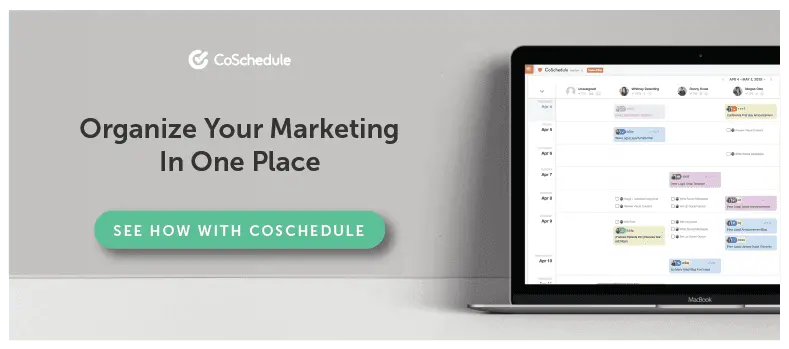
- This blog post was originally published on June 14, 2017. It was updated and republished on May 22, 2019.


